COMET Muon Transport Solenoid Installed in Hadron South Experimental Hall
Published : (Modified : )

© KEK IPNS
The COMET Experiment will search for muon-to-electron conversion, a possible rare decay mode of the muon, through an international collaboration between Japanese institutions such as KEK, Osaka University and Kyushu University, and more than 10 countries including the United Kingdom, China and Russia. It plans to achieve a world-record sensitivity to muon-to-electron conversion which is better by about a factor of 10,000 compared to previous experiments. COMET Phase-I is expected to start beam-running in 2018 - 2019.
The experimental facility is currently under construction in J-PARC, the Japan Proton Accelerator Research Complex at the KEK Tokai campus, and in March this year, the Hadron South Experimental Hall was completed, and one of the large superconducting magnets, the muon transport solenoid, was installed.
The Hadron South Experimental Hall consists of one underground experimental level and three above-ground floors which include a goods delivery area, a machine room, control rooms and computing rooms. The muon transport solenoid has the important role of carrying the muons that are produced at the proton beam target to the thin aluminium 'muon-stopping target', where muonic atmos will be formed.
The solenoid is about 7 metres long, spanning a 90-degree arc, and will have a field of about 3 T at its centre. Muons, produced through the decays of pions, travel along the magnetic field to the downsteam muon-stopping target. Because higher-momentum muons do not stop in the aluminium target but can instead be the source of background events, the ability of curved solenoids to separate particles by momentum is used to collimate away these muons.
Glossary
Muon-to-Electron Conversion
ミューオン稀過程の一つである「ミューオン - 電子転換過程」は、標準模型の枠内では起こりえない(荷電)レプトン世代数保存則が破れている過程です。 この過程の観測は、標準模型を超えた新しい物理モデルが背景にあることを示す直接的な証明となります。 また、観測できない場合も、分岐比を測定することで新しい物理モデルへの制限を与えることができます。
Lepton flavour violation
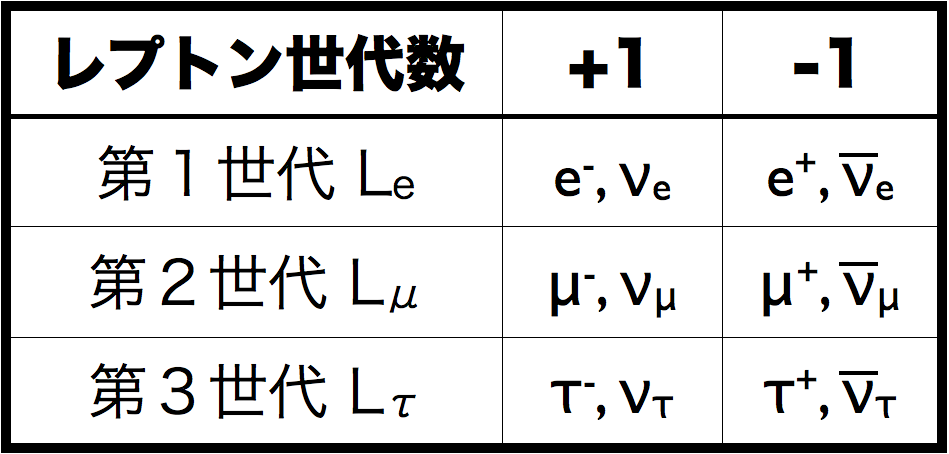
Fig. 1: Lepton Flavour Number
レプトン世代数とは、電子やニュートリノといったレプトンに割り当てられる量子数のことで、図1のように「粒子には1」、「反粒子には−1」を割り振ります。
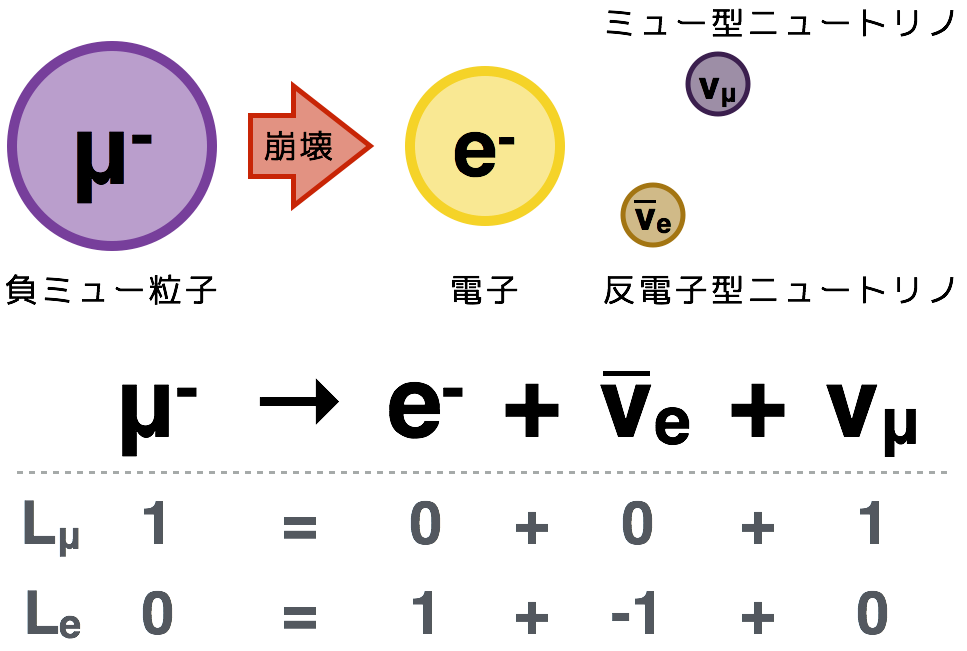
Fig. 2: Standard muon decay and lepton flavour number
通常の負ミューオンは図2のように、電子、反電子型ニュートリノとミュー型ニュートリノの3つの粒子に崩壊することがほとんどで、反応の前後でレプトン世代数に変化はありません。これをレプトン世代数保存則といいます。
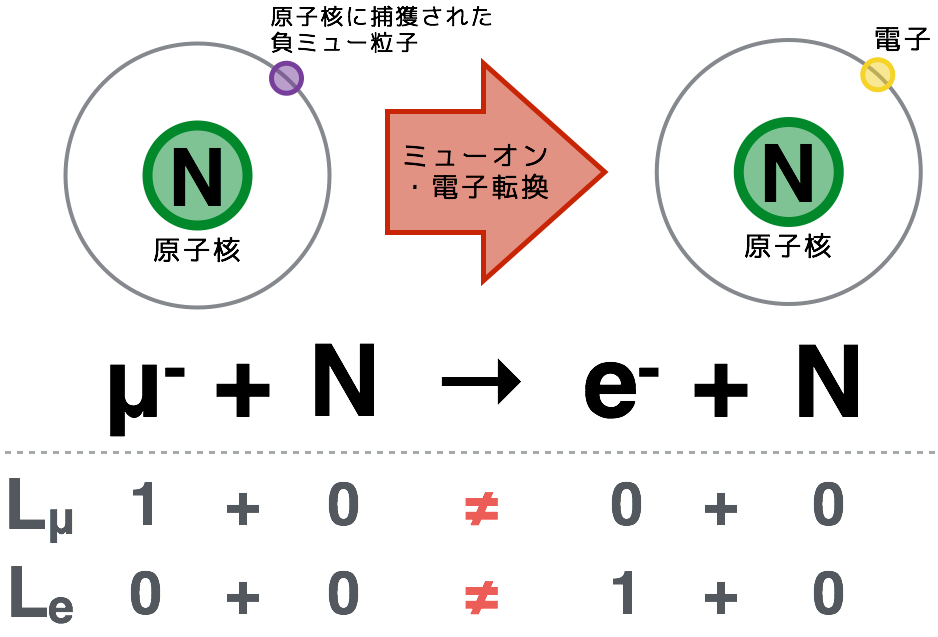
Fig. 3: Muon-to-Electron Conversion and lepton flavour number
COMET実験で探索する「ミューオン - 電子転換過程」は、図3のように、原子核に捕獲されたミューオンが、ニュートリノを出さずに電子へと変化する反応です。この反応の前後ではレプトン世代数が変化しています。 これをレプトン世代数保存則の破れといいます。
このように保存則が成り立たないことを、素粒子物理学者は「非保存」、「対称性の破れ」や単に「破れ」といいます(英語では「violation」といいます)
実は、中性レプトンであるニュートリノにおいては、レプトン世代数保存則を破る「ニュートリノ振動」という現象が発見されています。 現在の素粒子の標準模型にはニュートリノ振動の効果が加味され、ニュートリノを介してミューオンでもレプトン世代数保存則が破れている反応は起こりえますが、その確率が小さく、ミューオン - 電子転換過程は 10-50 以下であると予測されています。
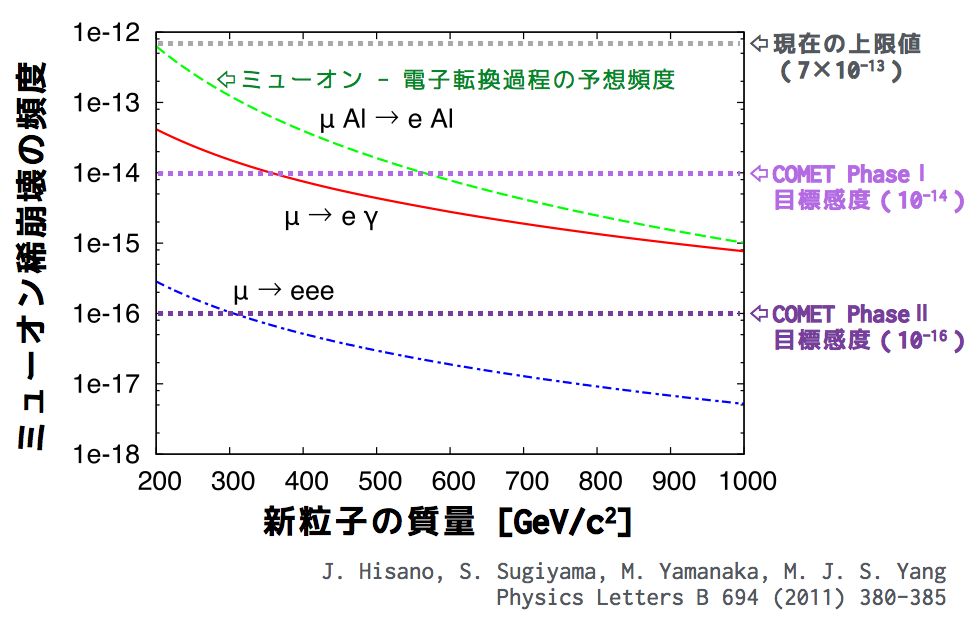
Fig. 4: The frequency of rare muon decays as a function of the mass of any new, Beyond-the-Standard Model, particle (a CP-odd Higgs). The dotted green curve is the rate of muon-to-electron conversion, and the solid red and dotted blue curves represent the rates for other rare muon decay processes.
図4はミューオン稀崩壊が起きる確率を描いたグラフです。 緑色の点線が、理論のモデル計算によるミューオン - 電子転換過程の予想頻度です。 右端にはこれまでの実験で得られている上限値とCOMET実験の第一期(Phase I)と第二期(Phase II)の目標感度を記しています。
新粒子が 1000 GeV/c2 以下の質量であれば、COMET実験によるミューオン - 電子転換過程の発見が期待できます。
The COMET Experiment
ミューオン稀過程の一つである「ミューオン - 電子転換過程」の探索を行います。 KEKや大阪大学、九州大学などの国内の大学・研究機関に加え、イギリス、中国、ロシアなど世界10カ国以上が参加する国際共同実験です。 これまでのミューオン - 電子転換過程の分岐比測定に比べ、感度をおよそ1万倍向上させ、世界最高感度での探索を目指します。
実験は、時期的・予算的に「Phase-I」と「Phase-II」の二段階に分けたアプローチを計画しています。 現在、COMET Phase-Iのため、J-PARCやKEKでミューオンビームラインやソレノイド磁石、検出器の建設が進んでいます。
図5はCOMET Phase-Iの概略図です。 実験は大きく分けて上流から「パイ中間子捕獲領域」、「パイ中間子崩壊・ミューオン輸送領域」、「検出器領域」の3つの領域で構成されています。 J-PARCの大強度陽子ビームをパイ中間子生成標的に照射し、大量のパイ中間子を作ります。 パイ中間子は、捕獲ソレノイド磁石によって効率的に収集され、90度に湾曲した輸送ソレノイド中を移動しながら、そのほとんどがミューオンに崩壊します。 このうち負電荷を持つ負ミューオンをアルミニウム製の静止標的に入射させると、アルミニウム原子の電子がひとつミューオンに置き換わった「ミューオン原子」となります。
ミューオン原子中のミューオンは、標準模型の枠内では、軌道上でニュートリノ2つと電子に崩壊するか、原子核に捕獲されニュートリノを放出します。 一方で、ミューオン - 電子転換過程が起こると、「105MeV/cの決まった運動量を持つ電子」が1つ放出されます。 放出される電子の運動量を観測することで、ミューオン - 電子転換過程を探索することができるのです。
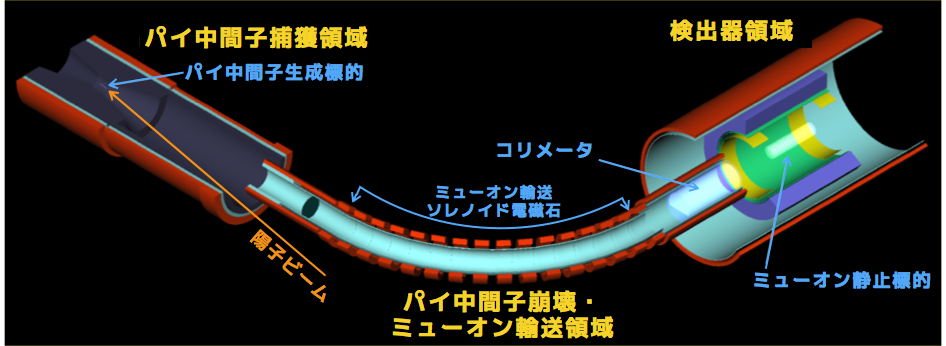
Fig. 5: COMET Phase-I. 実験は大きく分けて上流から「パイ中間子捕獲領域」、「パイ中間子崩壊・ミューオン輸送領域」、「検出器領域」の3つの領域で構成されている。 今回搬入した電磁石は2番目の領域の主要な機器です。